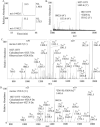Identification of the major site of O-linked beta-N-acetylglucosamine modification in the C terminus of insulin receptor substrate-1
- PMID: 16244361
- PMCID: PMC2435407
- DOI: 10.1074/mcp.M500314-MCP200
Identification of the major site of O-linked beta-N-acetylglucosamine modification in the C terminus of insulin receptor substrate-1
Abstract
Signal transduction from the insulin receptor to downstream effectors is attenuated by phosphorylation at a number of Ser/Thr residues of insulin receptor substrate-1 (IRS-1) resulting in resistance to insulin action, the hallmark of type II diabetes. Ser/Thr residues can also be reversibly glycosylated by O-linked beta-N-acetylglucosamine (O-GlcNAc) monosaccharide, a dynamic posttranslational modification that offers an alternative means of protein regulation to phosphorylation. To identify sites of O-GlcNAc modification in IRS-1, recombinant rat IRS-1 isolated from HEK293 cells was analyzed by two complementary mass spectrometric methods. Using data-dependent neutral loss MS3 mass spectrometry, MS/MS data were scanned for peptides that exhibited a neutral loss corresponding to the mass of N-acetylglucosamine upon dissociation in an ion trap. This methodology provided sequence coverage of 84% of the protein, permitted identification of a novel site of phosphorylation at Thr-1045, and facilitated the detection of an O-GlcNAc-modified peptide of IRS-1 at residues 1027-1073. The level of O-GlcNAc modification of this peptide increased when cells were grown under conditions of high glucose with or without chronic insulin stimulation or in the presence of an inhibitor of the O-GlcNAcase enzyme. To map the exact site of O-GlcNAc modification, IRS-1 peptides were chemically derivatized with dithiothreitol following beta-elimination and Michael addition prior to LC-MS/MS. This approach revealed Ser-1036 as the site of O-GlcNAc modification. Site-directed mutagenesis and Western blotting with an anti-O-GlcNAc antibody suggested that Ser-1036 is the major site of O-GlcNAc modification of IRS-1. Identification of this site will facilitate exploring the biological significance of the O-GlcNAc modification.
Figures





Similar articles
-
O-linked N-acetylglucosamine modification of insulin receptor substrate-1 occurs in close proximity to multiple SH2 domain binding motifs.Mol Cell Proteomics. 2009 Dec;8(12):2733-45. doi: 10.1074/mcp.M900207-MCP200. Epub 2009 Aug 11. Mol Cell Proteomics. 2009. PMID: 19671924 Free PMC article.
-
Mapping sites of O-GlcNAc modification using affinity tags for serine and threonine post-translational modifications.Mol Cell Proteomics. 2002 Oct;1(10):791-804. doi: 10.1074/mcp.m200048-mcp200. Mol Cell Proteomics. 2002. PMID: 12438562
-
O-GlcNAc modification on IRS-1 and Akt2 by PUGNAc inhibits their phosphorylation and induces insulin resistance in rat primary adipocytes.Exp Mol Med. 2005 Jun 30;37(3):220-9. doi: 10.1038/emm.2005.30. Exp Mol Med. 2005. PMID: 16000877
-
Cross-talk between GlcNAcylation and phosphorylation: roles in insulin resistance and glucose toxicity.Am J Physiol Endocrinol Metab. 2008 Jul;295(1):E17-28. doi: 10.1152/ajpendo.90281.2008. Epub 2008 Apr 29. Am J Physiol Endocrinol Metab. 2008. PMID: 18445751 Free PMC article. Review.
-
Proteomic approaches to analyze the dynamic relationships between nucleocytoplasmic protein glycosylation and phosphorylation.Circ Res. 2003 Nov 28;93(11):1047-58. doi: 10.1161/01.RES.0000103190.20260.37. Circ Res. 2003. PMID: 14645135 Review.
Cited by
-
O-GlcNAcomics--Revealing roles of O-GlcNAcylation in disease mechanisms and development of potential diagnostics.Proteomics Clin Appl. 2013 Oct;7(9-10):597-606. doi: 10.1002/prca.201300001. Epub 2013 Aug 6. Proteomics Clin Appl. 2013. PMID: 23640805 Free PMC article. Review.
-
Elevation of Global O-GlcNAc in rodents using a selective O-GlcNAcase inhibitor does not cause insulin resistance or perturb glucohomeostasis.Chem Biol. 2010 Sep 24;17(9):949-58. doi: 10.1016/j.chembiol.2010.07.005. Chem Biol. 2010. PMID: 20851344 Free PMC article.
-
O-GlcNAcylation of the Plum pox virus capsid protein catalyzed by SECRET AGENT: characterization of O-GlcNAc sites by electron transfer dissociation mass spectrometry.Amino Acids. 2011 Mar;40(3):869-76. doi: 10.1007/s00726-010-0706-0. Epub 2010 Jul 31. Amino Acids. 2011. PMID: 20676902 Free PMC article.
-
Glucosamine induces REDD1 to suppress insulin action in retinal Müller cells.Cell Signal. 2016 May;28(5):384-390. doi: 10.1016/j.cellsig.2016.01.017. Epub 2016 Feb 4. Cell Signal. 2016. PMID: 26852666 Free PMC article.
-
Extensive crosstalk between O-GlcNAcylation and phosphorylation regulates Akt signaling.PLoS One. 2012;7(5):e37427. doi: 10.1371/journal.pone.0037427. Epub 2012 May 22. PLoS One. 2012. PMID: 22629392 Free PMC article.
References
-
- Hart GW. Dynamic O-linked glycosylation of nuclear and cytoskeletal proteins. Annu. Rev. Biochem. 1997;66:315–335. - PubMed
-
- Comer FI, Hart GW. Reciprocity between O-GlcNAc and O-phosphate on the carboxyl terminal domain of RNA polymerase II. Biochemistry. 2001;40:7845–7852. - PubMed
-
- Slawson C, Hart GW. Dynamic interplay between O-GlcNAc and O-phosphate: the sweet side of protein regulation. Curr. Opin. Struct. Biol. 2003;13:631–636. - PubMed
-
- Iyer SP, Hart GW. Dynamic nuclear and cytoplasmic glycosylation: enzymes of O-GlcNAc cycling. Biochemistry. 2003;42:2493–2499. - PubMed
Publication types
MeSH terms
Substances
Grants and funding
LinkOut - more resources
Full Text Sources
Molecular Biology Databases

